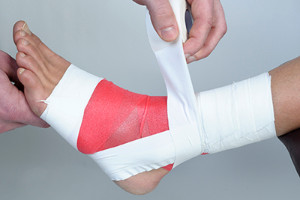 A large bump on the side of the big toe may be indicative of a bunion. It is considered to be a bone deformity, and can develop from wearing shoes that do not have adequate room for the toes to move freely in. The skin may appear red on and surrounding the bony protrusion, and a callus may develop over it. Some patients can experience pain and discomfort with bunions, and it may be difficult to wear shoes. Relief may be found if larger size shoes are worn, in addition to wearing protective pads over it that can provide cushioning. If you are afflicted with a bunion, it is suggested that you consult with a podiatrist who can provide correct treatment options, which may include surgery for permanent removal.
A large bump on the side of the big toe may be indicative of a bunion. It is considered to be a bone deformity, and can develop from wearing shoes that do not have adequate room for the toes to move freely in. The skin may appear red on and surrounding the bony protrusion, and a callus may develop over it. Some patients can experience pain and discomfort with bunions, and it may be difficult to wear shoes. Relief may be found if larger size shoes are worn, in addition to wearing protective pads over it that can provide cushioning. If you are afflicted with a bunion, it is suggested that you consult with a podiatrist who can provide correct treatment options, which may include surgery for permanent removal.
If you are suffering from bunions, contact one of our podiatrists of Westside Podiatry Center, LLP. Our doctors can provide the care you need to keep you pain-free and on your feet.
What Is a Bunion?
A bunion is formed of swollen tissue or an enlargement of boney growth, usually located at the base joint of the toe that connects to the foot. The swelling occurs due to the bones in the big toe shifting inward, which impacts the other toes of the foot. This causes the area around the base of the big toe to become inflamed and painful.
Why Do Bunions Form?
Genetics – Susceptibility to bunions are often hereditary
Stress on the feet – Poorly fitted and uncomfortable footwear that places stress on feet, such as heels, can worsen existing bunions
How Are Bunions Diagnosed?
Doctors often perform two tests – blood tests and x-rays – when trying to diagnose bunions, especially in the early stages of development. Blood tests help determine if the foot pain is being caused by something else, such as arthritis, while x-rays provide a clear picture of your bone structure to your doctor.
How Are Bunions Treated?
- Refrain from wearing heels or similar shoes that cause discomfort
- Select wider shoes that can provide more comfort and reduce pain
- Anti-inflammatory and pain management drugs
- Orthotics or foot inserts
- Surgery
If you have any questions, please feel free to contact one of our offices located in Liverpool, Camillus, Skaneateles, Oswego, and Cicero, NY . We offer the newest diagnostic and treatment technologies for all your foot care needs.









